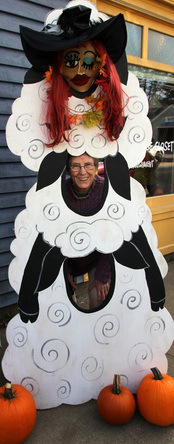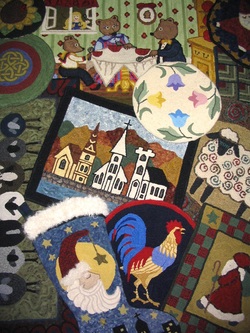Today I am going to explain step by step how to draw a design on a backing so that you can have the optimal rug hooking experience.
How to Transfer a Design From Red Dot to a Backing
First you will need to cut your piece of backing. If you pattern measures 22” x 30” the backing size should be 30” x 38”. This will allow for an excess of 4” per side to fit in a hoop or on a gripper frame and later for trimming and finishing. If you should purchase a pattern with very little excess edge, or if you are working with a smaller scrap, you can sew a piece of material to the edge so the pattern fits on the frame.
You always want to be careful cutting the backing to minimize fraying. Any cuts made crooked across the gain will fray like mad and you could lose a great deal of the border needed for binding the edge. Always zig zag the outside edges of the cut burlap to prevent fraying. (Some people use masking tape to protect the edge or duct tape).
Measure where you want to make the cut and use a pair of scissors to snip about an inch. Then pick up one of the backing fibers to the left or right of the cut and pull it through like a draw string all the way to the other side. Once this one strand is removed it will be very clear where to cut with your scissors. This is far easier and faster than trying to follow the straight of the grain with your scissors and your eye.
Below is the anal person’s guide to pattern transfer. If you are artistic and not uptight about marker mess, you can draw directly on the backing, although if you want to draw straight lines within the pattern or put on a border the same rules will apply.
1. First draw your design on paper. This allows you to make all changes that are easily corrected. Working directly on the backing with a marker will make mistakes permanent.
2. Secure the drawing to the table with tape to prevent slipping. Now place the red dot medium over your drawing and secure with stick pins or tape to the paper drawing. This prevents any slipping between the two layers as it can get annoying always trying to match up the lines once the red dot shifts.
3. You will be able to see your drawing through the red dot very clearly. Trace over all the lines of your pattern with either a pencil, pen or ultra-fine tipped marker. (An ultra-fine tipped marker works best because it flows over the red dot without having to apply pressure. Now your design will be on the red dot medium.
4. The Red dot medium has red dots that can be used to line up straight lines for borders etc. I don’t usually bother with this as most of my designs lines are not the exact place where the dots lay.
5. Markers do not have a long shelf life. Especially if you are tracing over burlap’s rougher surface. A heavy hand and too much pressure will wear the tip down faster. Linen patterns maximize the use of the marker as the surface is softer. Be prepared to go through one marker for a large pattern, maybe even crack open a second. Once the tip is worn off you can still use the marker for darkening lines until it dries out.
6. Position the red dot over your backing and secure it with stick pins.
7. Trace over the lines with a Sharpie marker or any marker with a point. The dye from the marker will bleed through the red dot to the backing. (We use Sharpie markers as they have a finer point and less odor. Anyone with allergies or sensitivities to strong smells will prefer them. If bothered by the marker wear a carbon filter mask, purchased at any hardware store.)
8. After you have traced over all the lines remove the red dot and you should see a perfect replica of your pattern. Now go over the lines on the backing to darken them. Don’t press too hard with the marker when working directly on the burlap as it is a rough surface and will wear off the tip fairly quickly. The tip is what gives you a fine line on your design, keeping it neat and detailed. Once the marker gets too dull it will make wider lines and if you are drawing smaller objects they will appear less defined and muddy. Note: Except for straight lines or borders all of the lines of a pattern can be transferred in this way.
9. When you have a straight line border or straight lines inside the pattern design, those lines will need to be drawn by hand with a pencil so they are straight on the grain. For single borderlines. If you have a design with a border that is 15” x 15” you would leave at least 3-4 inches along the outside edge so that the pattern will fit in your frame. This would mean that you are working with a piece of backing that is 19” x 19”. Take a ruler and measure in 4”. Find the closest hole/channel, take a pencil and drag it along the backing in that channel until it reaches 15” in length. Pay close attention as any distraction can make the pencil jump the channel into another line. Go over that channel the second time with the pencil to make the valley even more defined so later when you drag your marker through it will stay on the line. Then make the second side of your border until you reach 15”. Do the third side of the border and then close off with the fourth side. This will give you a nice straight edge of your pattern and make hooking so much easier.
10. All internal lines of the design have to be drawn by pencil as well. You can do this by dragging your pencil down the line on the red dot. The pencil will find the nearest channel and as you drag it down the line it will leave a dull pencil mark right on the backing. When you lift up the red dot you will see where to go over the area one more time with the pencil or use a marker to darken the line.
11. All geometric patterns like inch mats and anything with squares or straight lines are drawn by hand by dragging a pencil along the grain. Make sure the pencil is not too sharp or it won’t make the channel wide enough. After you have your lines drawn you can then drag your marker along those pencil lines to darken them. Hooking straight lines is so much easier than trying to hook a line that goes to the left and then the right of the grain.
There you go...101 of pattern transferring
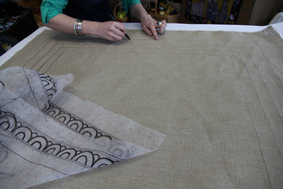
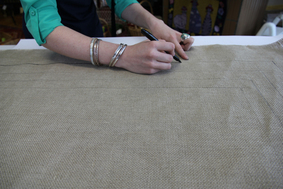
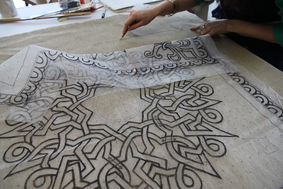
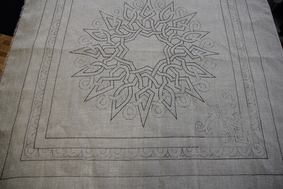
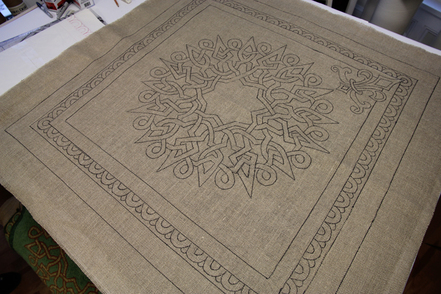



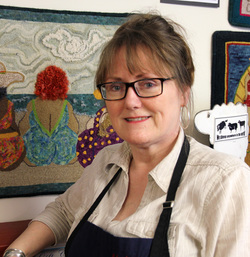

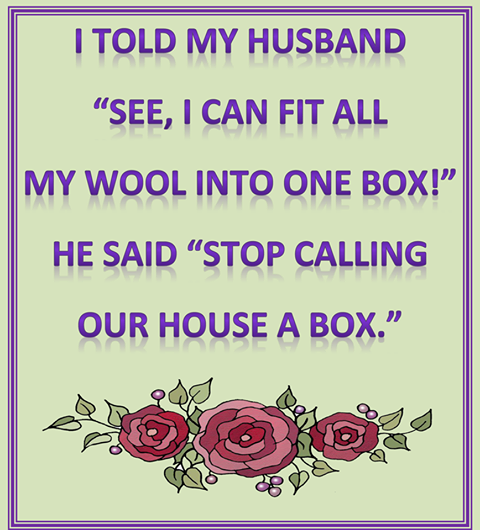

 RSS Feed
RSS Feed


